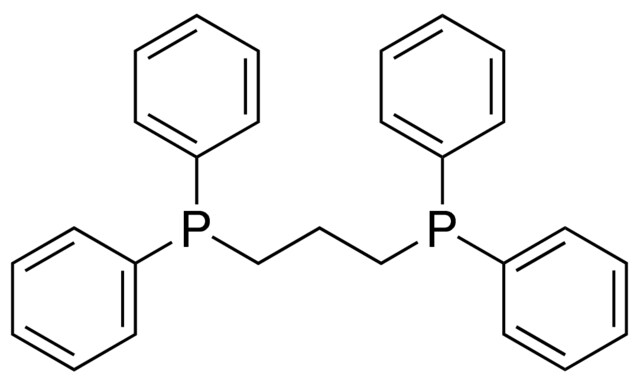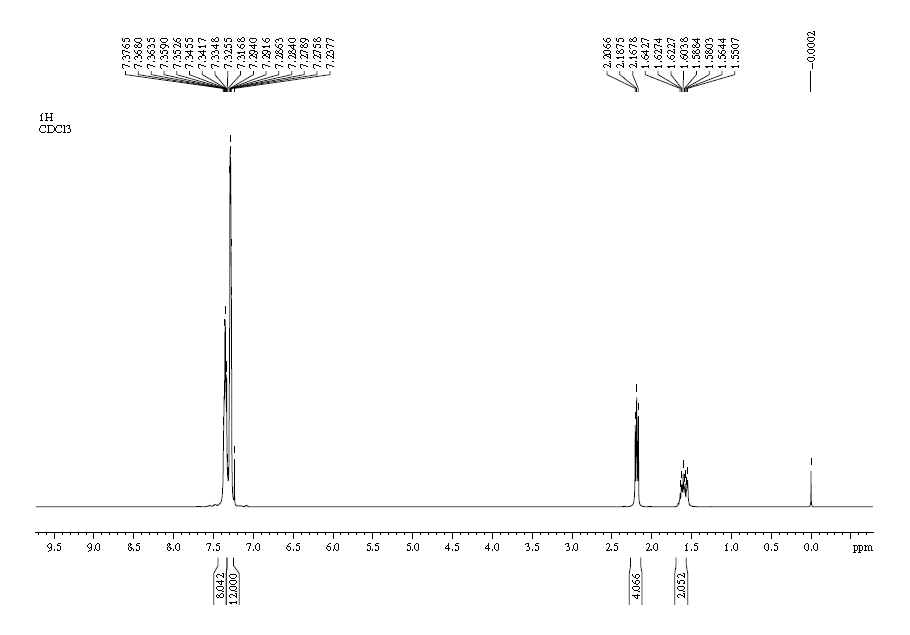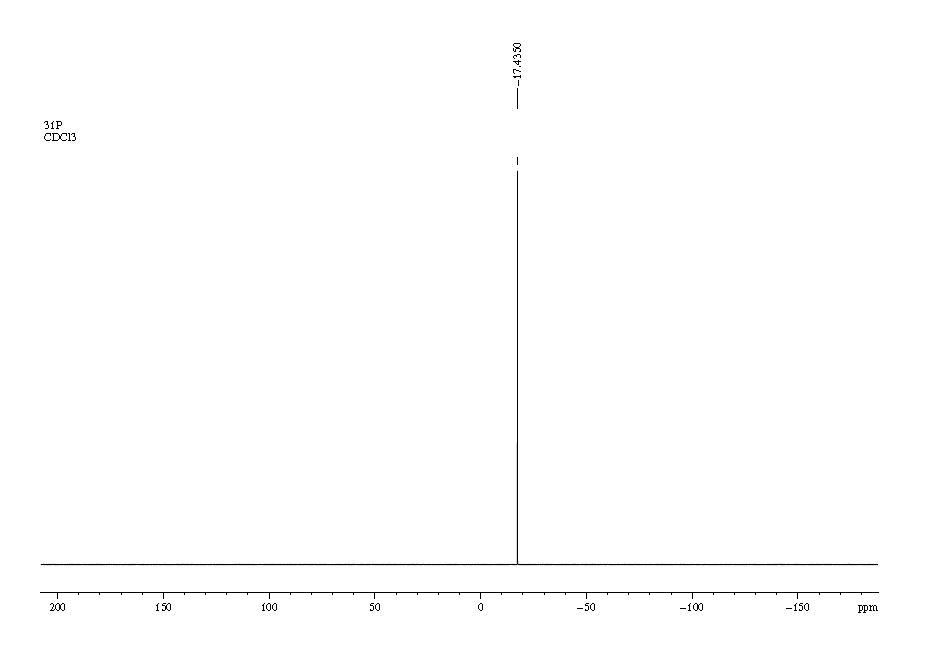1,3-Bis(diphenylphosphino)propane CAS#: 6737-42-4; ChemWhat Code: 38691
Identification
| Product Name | 1,3-Bis(diphenylphosphino)propane |
| IUPAC Name | 3-diphenylphosphanylpropyl(diphenyl)phosphane |
| Molecular Structure |  |
| CAS Registry Number | 6737-42-4 |
| EINECS Number | 229-791-2 |
| MDL Number | MFCD00003050 |
| Beilstein Registry Number | 2821785 |
| Synonyms | 1,3-bis-(diphenylphosphino)propanepropane-1,3-diylbis(diphenylphosphine)1,3-bis(diphenylphosphino)propanbis(diphenylphosphino)propanedppp1,3-bis(diphenylphosphanyl)propane1,3-bis(diphenylphosphine)propane1,3-bis(diphenylphosphaneyl)propane3-diphenylphosphanylpropyl(di-phenyl)phosphane |
| Molecular Formula | C27H26P2 |
| Molecular Weight | 412.44 |
| InChI | InChI=1S/C27H26P2/c1-5-14-24(15-6-1)28(25-16-7-2-8-17-25)22-13-23-29(26-18-9-3-10-19-26)27-20-11-4-12-21-27/h1-12,14-21H,13,22-23H2 |
| InChI Key | LVEYOSJUKRVCCF-UHFFFAOYSA-N |
| Canonical SMILES | c1ccc(cc1)P(CCCP(c2ccccc2)c3ccccc3)c4ccccc4 |
| Patent Information | ||
| Patent ID | Title | Publication Date |
| CN113861237 | Organic phosphorus ligand as well as preparation method and application thereof | 2021 |
| US2013/85127 | HETEROCYCLIC COMPOUND AND H1 RECEPTOR ANTAGONIST | 2013 |
Physical Data
| Appearance | White or off-white solid |
| Solubility | No data available |
| Flash Point | No data available |
| Refractive index | No data available |
| Sensitivity | No data available |
| Melting Point, °C | Solvent (Melting Point) |
| 61 – 63 | |
| 63 | ethanol |
| 63.3 – 65.3 | |
| 60.5 – 62 | petroleum ether |
| 89 |
| Description (Association (MCS)) | Solvent (Association (MCS)) | Temperature (Association (MCS)), °C | Partner (Association (MCS)) |
| NMR spectrum of the complex | Zeolite HY | ||
| NMR spectrum of the complex | CDCl3 | -50.1 | AgSCN |
| NMR spectrum of the complex | CDCl3 | -20.1 | AgCl |
| NMR spectrum of the complex | CD2Cl2, CH2Cl2 | -40.1 | AgI |
Spectra
| Description (NMR Spectroscopy) | Nucleus (NMR Spectroscopy) | Solvents (NMR Spectroscopy) | Temperature (NMR Spectroscopy), °C | Frequency (NMR Spectroscopy), MHz |
| Chemical shifts | 31P | |||
| Chemical shifts, Spectrum | 1H | chloroform-d1 | 400 | |
| Chemical shifts, Spectrum | 13C | chloroform-d1 | 100 | |
| Chemical shifts, Spectrum | 31P | hexadeuterobenzene | 25 | 161 |
| Description (IR Spectroscopy) | Solvent (IR Spectroscopy) | Comment (IR Spectroscopy) |
| Spectrum | ||
| Bands, Spectrum | ||
| ATR (attenuated total reflectance), Bands, Spectrum | potassium bromide | |
| Bands | 3069 – 436 cm**(-1) | |
| Spectrum |
| Description (Mass Spectrometry) |
| EI (Electron impact), Spectrum |
| electron impact (EI), spectrum |
| Description (UV/VIS Spectroscopy) | Solvent (UV/VIS Spectroscopy) | Absorption Maxima (UV/VIS), nm | Ext./Abs. Coefficient, l·mol-1cm-1 |
| Spectrum | dichloromethane | ||
| chloroform | 310 | 223 |
| Description (Raman Spectroscopy) | Comment (Raman Spectroscopy) |
| Bands | neat (no solvent, solid phase) |
Route of Synthesis (ROS)
| Conditions | Yield |
| With diisobutylaluminium hydride In toluene at 150℃; for 12h; Inert atmosphere; | 93% |
| With 1,1,3,3-Tetramethyldisiloxane; titanium(IV) isopropylate In various solvent(s) at 100℃; for 7h; | 91% |
| With diethoxymethylane; Bis(p-nitrophenyl) phosphate In toluene at 110℃; Inert atmosphere; chemoselective reaction; | 82% |
| With indium(III) bromide; 1,1,3,3-Tetramethyldisiloxane In toluene at 100℃; for 22h; Inert atmosphere; Sealed tube; | 80% |
| With hexylsilane; trifluorormethanesulfonic acid In toluene at 70℃; for 24h; Inert atmosphere; Sealed tube; chemoselective reaction; | 72 %Spectr. |
Safety and Hazards
| Pictogram(s) |   |
| Signal | Warning |
| GHS Hazard Statements | H302 (57.26%): Harmful if swallowed [Warning Acute toxicity, oral] H315 (100%): Causes skin irritation [Warning Skin corrosion/irritation] H317 (57.26%): May cause an allergic skin reaction [Warning Sensitization, Skin] H319 (100%): Causes serious eye irritation [Warning Serious eye damage/eye irritation] H335 (100%): May cause respiratory irritation [Warning Specific target organ toxicity, single exposure; Respiratory tract irritation] H400 (57.26%): Very toxic to aquatic life [Warning Hazardous to the aquatic environment, acute hazard] H410 (58.06%): Very toxic to aquatic life with long lasting effects [Warning Hazardous to the aquatic environment, long-term hazard] |
| Precautionary Statement Codes | P261, P264, P264+P265, P270, P271, P272, P273, P280, P301+P317, P302+P352, P304+P340, P305+P351+P338, P319, P321, P330, P332+P317, P333+P313, P337+P317, P362+P364, P391, P403+P233, P405, and P501 (The corresponding statement to each P-code can be found at the GHS Classification page.) |
| SDS Download | English Version |
Other Data
| Transportation | NONH for all modes of transport |
| Under the room temperature and away from light | |
| HS Code | No data available |
| Storage | Under the room temperature and away from light |
| Shelf Life | 1 year |
| Market Price | USD |
| Druglikeness | |
| Lipinski rules component | |
| Molecular Weight | 412.451 |
| logP | 8.998 |
| HBA | 0 |
| HBD | 0 |
| Matching Lipinski Rules | 3 |
| Veber rules component | |
| Polar Surface Area (PSA) | 27.18 |
| Rotatable Bond (RotB) | 8 |
| Matching Veber Rules | 2 |
| Use Pattern |
| 1,3-Bis(diphenylphosphino)propane CAS#: 6737-42-4 as General chemicals |
| 1,3-Bis(diphenylphosphino)propane CAS#: 6737-42-4 as hydrogenating an alkynol selectively to an alkenol |
| 1,3-Bis(diphenylphosphino)propane CAS#: 6737-42-4 as Ligand |
| component of transition-metal catalyst for synthesis of annelated benzimidazoles and azabenzimidazoles |
| organic ligand for the preparation of adapalene |
Buy Reagent | |
| No reagent supplier? | Send quick inquiry to ChemWhat |
| Want to be listed here as a reagent supplier? (Paid service) | Click here to contact ChemWhat |
Approved Manufacturers | |
| Warshel Chemical Ltd | http://www.warshel.com/ |
| Want to be listed as an approved manufacturer (Requires approvement)? | Please download and fill out this form and send back to approved-manufacturers@chemwhat.com |
Contact Us for Other Help | |
| Contact us for other information or services | Click here to contact ChemWhat |



